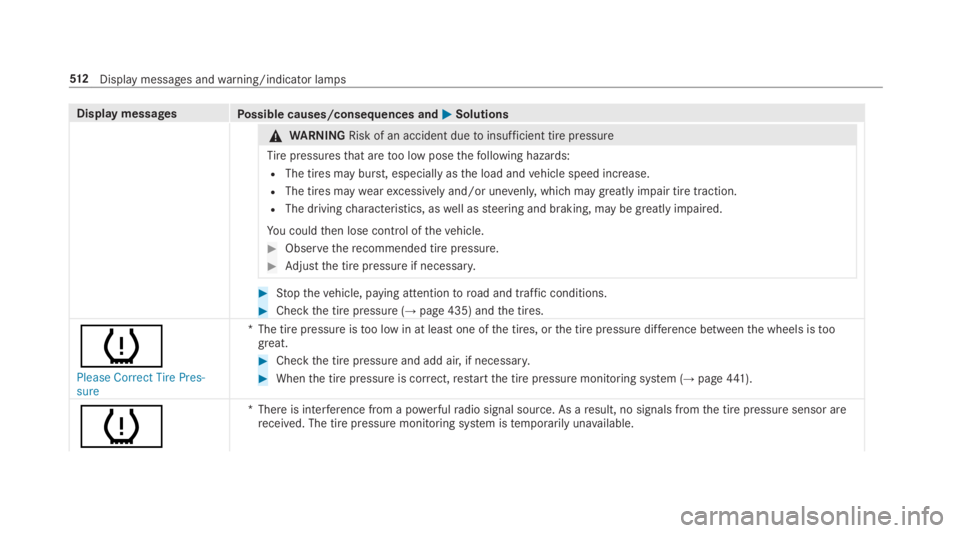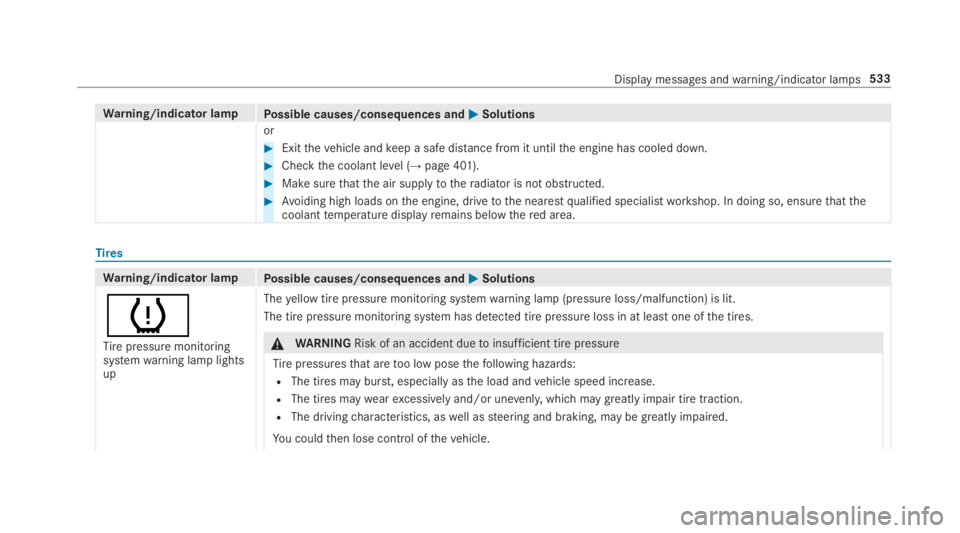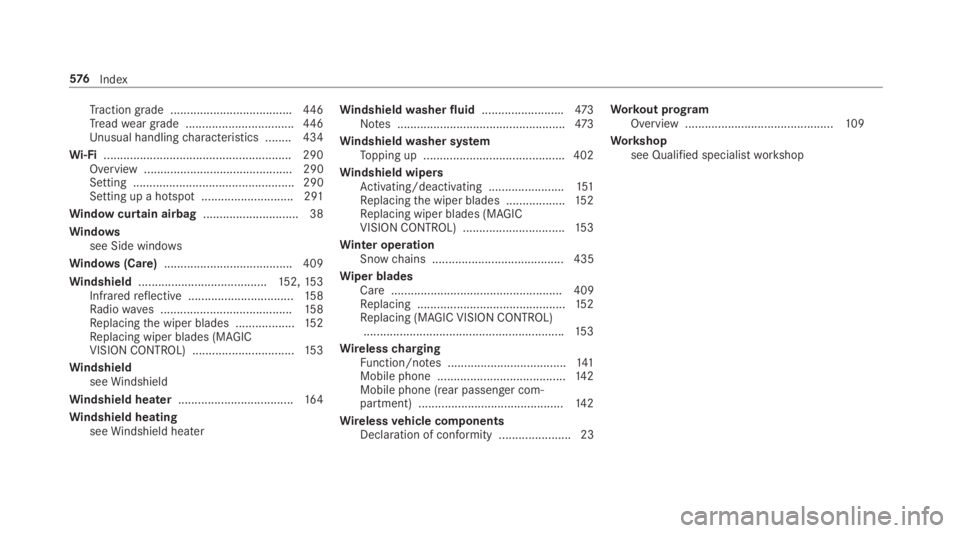2019 MERCEDES-BENZ S CLASS traction control
[x] Cancel search: traction controlPage 448 of 578

Tirelabeling
Overview of tire labeling
1Uniform TireQuality GradingStandard(→page446)
2DOT,TireIdentificationNumber(→page447)
3Maximum tire load (→page448)
4Maximum tire pressure (→page448)
5Manufacturer
6Characteristics ofthe tire (→page449)
7Tiresize designation, load-bearing capacity,speedrating and load index (→page449)
8Tirename
%The datashown inthe image isexampledata.
TireQuality Grading
In accordance withthe US Department ofTrans‐portation's "Uniform TireQuality GradingStand‐ards", tire manufacturers arerequiredtogradetheir tires onthe basis ofthefollowingthree per‐formancefactors:
1Treadweargrade
2Tractiongrade
3Temperature grade
%The data shown inthe image isexampledata.
%The classification is not legallystipulatedforCanada, but it isgenerallystated.
TreadweargradeThe treadwear grade is a comparativeratingbased onthewearrateofthe tire whentestedunder controlled conditions on a specifiedtesttrack ofthe US Department ofTransportation.Forexample, a tiregraded150wouldwear one
446Wheels and tires
Page 449 of 578

and one-half times aswell onthe governmenttesttrack as a tire graded100.
Therelative performance of tires depends uponthe actual conditions oftheir use, however,andmay depart significantly fromthe norm duetovariations in driving habits, service practices anddifferences inroadcharacteristics and climateconditions.
Tractiongrade
&DANGERRisk of accident duetoinade‐quate traction
The tractiongrade assignedtothis tire isbased onstraight-ahead braking tractiontests, and does not include either accelera‐tion, cornering,hydroplaning or peak tractioncharacteristics.
#Always adaptyour drivingstyle anddrive at a speedtosuitthe prevailingtraffic andweather conditions.
*NOTEDamagetothe drivetrain fromwheelspin
#Avoid wheelspin.
The traction grades – from highesttolowest –are AA,A,B and C. Those gradesrepresentthetire's abilitytostop onwet pavement as meas‐ured under controlled conditions on specifiedgovernmenttestsurfaces made of asphalt andconcrete.
Temperaturegrade
&WARNINGRisk of accident from tireoverheating and tirefailure
Thetemperature gradeforthis tire is estab‐lishedfor a tirethat is properly inflated andnotoverloaded. Excessive speed, underinfla‐tion, orexcessive loading, either separatelyor in combination, can causeexcessive heatbuild-up and possible tirefailure.
#Observetherecommended tire pres‐sures andregularlycheckthe tire pres‐
sure of all tires includingthe sparewheel.
#Adjustthe tire pressure as necessary.
Thetemperature grades are A (the highest), Band C. Theyrepresentthe tire'sresistancetothegeneration of heat and its abilitytodissipateheat whentested under controlled conditions ona specified indoor laboratorytestwheel. Sus‐tained hightemperature can causethe materialofthe tiretodegenerate andreduce tire life, andexcessivetemperature can leadtosudden tirefailure. Grade C correspondstoa level of per‐formance which all passenger car tires mustmeet undertherequirements ofthe US Depart‐ment ofTransportation.
DOT,TireIdentificationNumber (TIN)
US tireregulationsstipulatethateverytire man‐ufacturer orretreader mustimprint a TIN in oronthe sidewall of each tire produced.
Wheels and tires447
Page 455 of 578

these are installed onthevehicle, but does notinclude passengers or luggage.
Maximum tire load:the maximum tire load isthe maximum permissibleweight in kilograms orlbsfor whicha tire is approved.
Maximum permissible tire pressure:maxi‐mum permissible tire pressurefor one tire.
Maximum load on one tire:maximum load onone tire. This is calculatedbydividingthe maxi‐mum axle load of one axlebytwo.
PSI (pounds per square inch):standard unit ofmeasurementfor tire pressure.
Aspectratio:ratio between tire height and tirewidth in percent.
Tirepressure:pressure insidethe tire applyingan outwardforcetoeverysquare inch ofthe tire.The tire pressure is specified in pounds persquare inch (psi), in kilopascals (kPa) or in bar.The tire pressure should only be corrected whenthe tires are cold.
Cold tire pressure:the tires are cold whenthevehicle has been parkedfor at least3 hours
without direct sunlight onthe tires orthevehiclehas been drivenfor lessthan 1 mile (1.6 km).
Tirecontact surface:the part ofthe tirethatcomes into contact with theroad.
Tirebead:the purpose ofthe tire bead istoensurethatthe tire sits securely onthe wheelrim. There are several wire cores inthe tire beadtopreventthe tire fromchanging length onthewheelrim.
Sidewall:the part ofthe tire betweenthe treadandthe tire bead.
Weight of optional equipment:the combinedweight ofthe optional equipmentweighing morethanthereplacedstandard parts and morethan5 lbs (2.3kg).This optional equipment, such ashigh-performance brakes, level control system, aroof luggagerackor high-performance batteries,is not included inthe curbweight andtheweightofthe accessories.
TIN (Tire IdentificationNumber):a uniqueidentification number which can be usedby atire manufacturertoidentify tires,forexample,in a productrecall, andthus identifythe pur‐chasers. The TIN is made up ofthe manufactur‐
er's identity code, tire size, tire type code andthe manufacturing date.
Load-bearing index:the load-bearing index is acodethat containsthe maximum load-bearingcapacity of a tire.
Traction:traction isthe gripresulting from fric‐tion betweenthe tires andtheroad surface.
Wear indicator:narrowbars (treadwear bars)that are distributedoverthe tire contact surface.Ifthe tire tread is level withthe bars,thewearlimit of 1/16in (1.6 mm) has beenreached.
Distribution ofvehicle occupants:distributionofvehicle occupantsover designated seat posi‐tions in avehicle.
Maximum permissible payloadweight:nomi‐nal load and luggage load plus150 lb (68kg)multipliedbythe number of seats inthevehicle.
Wheels and tires453
Page 514 of 578

Display messagesPossible causes/consequences and�P�PSolutions
&WARNINGRisk of an accident duetoinsufficient tire pressure
Tirepressuresthat aretoo low posethefollowing hazards:
RThe tires may burst, especially asthe load andvehicle speed increase.
RThe tires maywearexcessively and/or unevenly,which may greatly impair tire traction.
RThe drivingcharacteristics, aswell assteering and braking, may be greatly impaired.
You couldthen lose control ofthevehicle.
#Observetherecommended tire pressure.
#Adjustthe tire pressure if necessary.
#Stopthevehicle, paying attentiontoroad and traffic conditions.
#Checkthe tire pressure (→page 435) andthe tires.
�w
Please Correct Tire Pres-sure
*The tire pressure istoo low in at least one ofthe tires, orthe tire pressure difference betweenthe wheels istoogreat.
#Checkthe tire pressure and add air, if necessary.
#Whenthe tire pressure is correct,restartthe tire pressure monitoring system (→page441).
�w
*There is interference from a powerfulradio signal source. As aresult, no signals fromthe tire pressure sensor arereceived. The tire pressure monitoring system istemporarily unavailable.
512Displaymessages andwarning/indicator lamps
Page 535 of 578

Warning/indicator lampPossible causes/consequences and�P�PSolutions
or
#Exitthevehicle andkeep a safe distance from it untilthe engine has cooled down.
#Checkthe coolant level (→page 401).
#Make surethatthe air supplytotheradiator is not obstructed.
#Avoiding high loads onthe engine, drivetothe nearestqualified specialistworkshop. In doing so, ensurethatthecoolanttemperature displayremains belowthered area.
Tires
Warning/indicator lampPossible causes/consequences and�P�PSolutions
�w
Tirepressure monitoringsystemwarning lamp lightsup
Theyellow tire pressure monitoring systemwarning lamp (pressure loss/malfunction) is lit.
The tire pressure monitoring system has detected tire pressure loss in at least one ofthe tires.
&WARNINGRisk of an accident duetoinsufficient tire pressure
Tirepressuresthat aretoo low posethefollowing hazards:
RThe tires may burst, especially asthe load andvehicle speed increase.
RThe tires maywearexcessively and/or unevenly,which may greatly impair tire traction.
RThe drivingcharacteristics, aswell assteering and braking, may be greatly impaired.
You couldthen lose control ofthevehicle.
Display messages andwarning/indicator lamps533
Page 573 of 578

Notes on installing ...............................454Overview of tire labeling ......................446Removing ............................................. 461Replacing .................................... 454, 458Restartingthe tire pressure monitor‐ing system ...........................................441Rotating ............................................... 456Selection .............................................454Snowchains ........................................ 435Speedrating ........................................449Storing .................................................457Temperature grade ..............................446Tireand Loading Information placard.............................................................442Tirepressure (notes) ........................... 435Tirepressure monitoring system(function) ............................................. 439Tirepressuretable .............................. 437TireQuality Grading .............................446Tiresize designation ............................449TIREFIT kit ............................................41 5Tractiongrade .....................................446Treadwear grade .................................446Unusual handlingcharacteristics ........ 434
Toll systemWindshield ...........................................15 8
ToolseeVehicletool kit
TopTether.................................................. 55
Total distance.......................................... 257Displaying ............................................ 257
Touch Control..........................................279On-board computer ............................. 252Operating ............................................279Settingthe sensitivity ..........................279
Touchpad.................................................. 280Activating/deactivating haptic oper‐ationfeedback .....................................281Operating ............................................ 280Readingthe handwritingrecognitionaloud ................................................... 281Selecting astation and track ...............281Settingthe sensitivity .......................... 281Switching on/off ................................. 280
Tow-bar system.......................................249
Tow-starting............................................. 430
Towingaway............................................ 426
TowingeyeInstalling .............................................. 429Storage location ..................................429
Towing methods...................................... 424
TrackSelecting (audio mode) ....................... 358
Tractiongrade.........................................446
Traffic information...................................318Displayingthe traffic map ....................319Displaying traffic incidents .................. 320Extending a LiveTraffic Informationsubscription .........................................318Issuing hazardwarnings ...................... 320LiveTraffic Information ........................318Overview ..............................................318
Traffic mapsee Map
Traffic Sign Assist...................................239Function/notes ................................... 239Setting .................................................240System limitations ...............................239
Transferredvehicle dataAndroidAuto....................................... 342
Index571
Page 578 of 578

Tractiongrade .....................................446Treadwear grade .................................446Unusual handlingcharacteristics ........ 434
Wi-Fi.........................................................290Overview ............................................. 290Setting ................................................. 290Setting up a hotspot ............................ 291
Window curtain airbag............................. 38
Windowssee Side windows
Windows(Care).......................................409
Windshield.......................................152,15 3Infraredreflective ................................15 8Radiowaves ........................................158Replacingthe wiper blades ..................15 2Replacing wiper blades (MAGICVISIONCONTROL) ...............................15 3
WindshieldseeWindshield
Windshield heater...................................16 4
Windshield heatingseeWindshield heater
Windshieldwasher fluid.........................473Notes ...................................................473
Windshieldwasher systemTopping up ...........................................402
Windshield wipersActivating/deactivating .......................151Replacingthe wiper blades ..................15 2Replacing wiper blades (MAGICVISIONCONTROL) ...............................15 3
Winter operationSnowchains ........................................ 435
Wiper bladesCare.................................................... 409Replacing .............................................152Replacing (MAGIC VISIONCONTROL).............................................................153
WirelesschargingFunction/notes ....................................141Mobile phone .......................................14 2Mobile phone (rear passenger com‐partment) ............................................14 2
Wirelessvehicle componentsDeclaration of conformity ...................... 23
Workout programOverview .............................................109
Workshopsee Qualified specialistworkshop
576Index